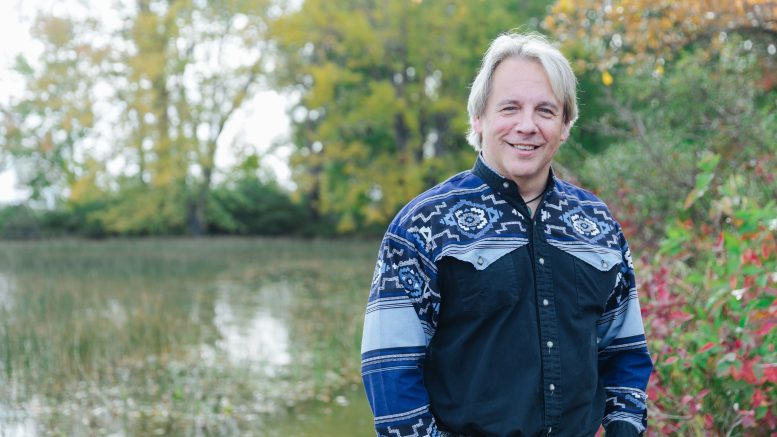Prolific playwright Drew Hayden Taylor addressed a full house at the John J. Conklin Theatre on Jan. 19 as the department of English, theatre, film & media’s (ETFM) 2023 Sidney Warhaft Memorial lecturer.
The event began with associate professor Lucas Tromly presenting the Professor Sidney Warhaft Memorial Award for best master’s thesis to recent ETFM grad Kerri Woloszyn.
ETFM professor Warren Cariou introduced Taylor by enumerating the playwright’s accomplishments and accolades. Cariou noted Taylor’s “remarkably generative imagination,” his “wonderfully trickster-ish sense of humour” and his history of uplifting “emerging Indigenous writers and theatre artists.”
Taylor’s talk tracked his career from his home in Curve Lake First Nation to his present-day world-renown as he continues “spreading the gospel of Native literature.”
Taylor explained in the lecture that his earliest childhood memories are papered with stories, literature and his yearning to absorb them, even before he knew how to read.
“Every book I read was a passport,” he said.
But while Taylor’s interest in storytelling grew, he was unsure about what doors lay open for him as an artist. He noted that First Nations people only gained the federal vote in 1960 — just two years before he was born — and explained that because of the historical disenfranchisement of Indigenous peoples, as well as the lack of any Indigenous literature in his school, he did not know whether Indigenous people were even allowed to write.
Taylor also spoke of a harsh lesson he learned from his elders — creative writing is not a lucrative field for most people.
“My mother looked at me with a very forlorn look and said, and I quote, ‘why do you want to be a writer? It’s not going to get you anywhere,’” he explained.
Taylor then shared that, after spending some time in university developing his journalistic writing abilities, he became increasingly aware of a dearth of Indigenous scriptwriters, even on projects that were telling Indigenous stories.
It was in that gap that Taylor found an opportunity to contribute his perspective as an Indigenous person to the world of television.
Taylor explained that his breakout writing role for television was fuelled by his desire to rectify that lack of Indigenous representation, as well as a general need for paid work. After sending story ideas to a network on a whim, one of Taylor’s pitches was accepted for an episode of The Beachcombers.
Running parallel to his career was what Taylor called “the contemporary Native literary renaissance” of the late ’80s and early ’90s. The movement included writers like Jeannette Armstrong, Lee Maracle and Maria Campbell.
Amidst this booming interest in Indigenous stories, Taylor expressed his hesitancy about the overall creative landscape that was taking shape. He explained that a large majority of Indigenous narratives were “dark, depressing, bleak, sad and angry.”
“Most of the characters were either oppressed, depressed or suppressed,” he said.
Taylor described this development as a necessary step that Indigenous artists had to take to begin a collective convalescence from colonial violence, racism, the residential school system and the “dysfunctional aspects” those structures produced.
Taylor then explained that while telling these kinds of grim stories was “a cathartic thing,” he felt that an over-representation of these types of stories in his milieu did not reflect the varied textures of real Indigenous peoples’ lives, including his own.
“I would look at my mother, and my mother was a very vivacious woman with a great sense of humour and I wasn’t seeing her in a lot of this literature,” he said.
“Maybe [The] Rez Sisters, but other than that, our life was not doom and gloom.”
In fostering his own creative voice, Taylor described his realization that humour was also a necessary step to healing.
“I wanted to take it to the next step and deal with the potential power of humour as a healing medium,” he explained.
“I knew the power of Indigenous humour, I know the humour that existed in most Native communities.”
Taylor pulled on that power very early in his career. When his first comedy play premiered, the audience of mostly white people was silent. Taylor recalled a small group of Indigenous people laughing raucously. Their joy was infectious, and soon the entire theatre joined in.
Taylor suspected that white audience members were unsure of laughing even at Indigenous comedic narratives because Indigenous people had been through so much.
With his plays translated into multiple languages and his career veering into novel writing and feature film directing, Taylor’s story is a testament to the global resonances in Indigenous stories.
Taylor ended his talk with an energetic remark on the many diverse genres and mediums that Indigenous storytellers are now working with.
Money matters came up repeatedly in Taylor’s lecture. Regardless of the artist’s passion or talent, financial support frees him up to be able to create. Taylor’s career also serves as a reminder that many potentially prolific, storied artists are buried in bills to pay, and are one creative lottery away from connecting with audiences around the world.
For more information about Drew Hayden Taylor’s work, visit https://www.drewhaydentaylor.com/.





